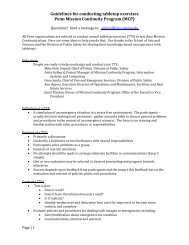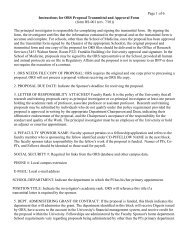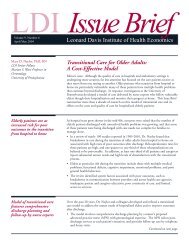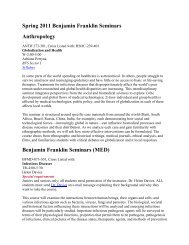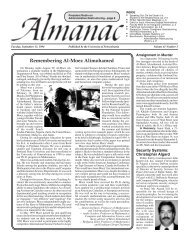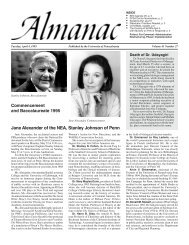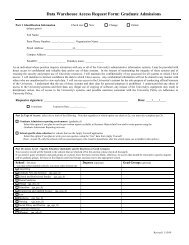2009-2010 COURSE REGISTER - University of Pennsylvania
2009-2010 COURSE REGISTER - University of Pennsylvania
2009-2010 COURSE REGISTER - University of Pennsylvania
Create successful ePaper yourself
Turn your PDF publications into a flip-book with our unique Google optimized e-Paper software.
This course introduces the study <strong>of</strong> animal<br />
bones from archaeological sites. Faunal<br />
analysis is an interdisciplinary science<br />
which draws methods from archaeology,<br />
biology, and paleontology. Bones, shells,<br />
and other remains yield evidence for the<br />
use <strong>of</strong> animals by humans, and evidence for<br />
the biology <strong>of</strong> animals and for past<br />
environments. The course will focus on<br />
research approaches to important<br />
transitions in human-animal relationships:<br />
the development <strong>of</strong> human hunting and<br />
fishing, animal domestication, early<br />
pastoralism, and the emergence <strong>of</strong> market<br />
economies in animal products. Class<br />
presentations will include lectures and<br />
discussion concerning research design and<br />
archaeological case material, with<br />
additional videos, slidework with field and<br />
laboratory equipment, and supervised work<br />
identifying and darchaeological materials<br />
from Museum collections.<br />
SM 416. (COMM420) Public Interest<br />
Anthropology. (C) Sanday.<br />
Prerequisite(s): ANTH 002 or permission<br />
<strong>of</strong> instructor.<br />
Because <strong>of</strong> its four-field, holistic approach<br />
anthropology is uniquely equipped to<br />
address a wide range <strong>of</strong> public and<br />
community service issues such as health,<br />
teen pregnancy, sexuality, domestic<br />
violence, ebonics, race, repatriation, and<br />
cultural heritage. Because <strong>of</strong> its emphasis<br />
on participant observation and seeing<br />
things from "the other's" point <strong>of</strong> view,<br />
anthropological methods are helpful to all<br />
pr<strong>of</strong>essionals working in the U.S. public<br />
sphere, be it government, law, education, or<br />
health fields. This course introduces the<br />
student to public service issues, from the<br />
perspective <strong>of</strong> selected Penn anthropology<br />
faculty. Lectures will be given by faculty<br />
representing the four fields. With the<br />
course coordinator, students will be<br />
encouraged to pursue several public interest<br />
issues <strong>of</strong> their choice. Undergraduate and<br />
graduate students from all departments and<br />
schools are encouraged to take the course.<br />
422. Computer Applications in<br />
Anthropology. (M) Dibble. May be<br />
repeated for credit.<br />
Presentation <strong>of</strong> computer applications<br />
relevant to anthropological field work and<br />
analysis, primarily based on micro or<br />
portable computers. Focus each year will<br />
vary depending on development <strong>of</strong> new<br />
applications and the interests <strong>of</strong> students.<br />
433. (LALS433) Andean<br />
Archaeology. (M) Erickson.<br />
Consideration <strong>of</strong> culture history <strong>of</strong> native<br />
peoples <strong>of</strong> Andean area, with emphasis on<br />
pre-conquest archaeology <strong>of</strong> Central<br />
Andean region.<br />
SM 437. (GAFL474, HSOC437)<br />
Cultural Models & Health. (C)<br />
Distribution Course in Society. Class <strong>of</strong><br />
<strong>2009</strong> & prior only. Barg.<br />
There is a great deal <strong>of</strong> variation among<br />
population groups in the incidence <strong>of</strong> and<br />
mortality from most major diseases.<br />
Biological and social factors can account<br />
for some <strong>of</strong> this variation. However, there<br />
is increasing evidence that behavior- and<br />
the cultural models that are linked to health<br />
behavior- play an important role, too.<br />
Cognitive anthropology is the study <strong>of</strong> how<br />
peoplein social groups conceive <strong>of</strong> objects<br />
and events in their world. It provides a<br />
framework for understanding how members<br />
<strong>of</strong> different groups categorize illness and<br />
treatment. It also helps to explain why risk<br />
perception, helpseeking behavior, and<br />
decision making styles vary to the extent<br />
they do. This seminar will explore the<br />
history <strong>of</strong> cognitive anthropology, schema<br />
theory, connectionism, the role <strong>of</strong> cultural<br />
models, and factors affecting health<br />
decision making. Methods for identifying<br />
cultural models will be discussed and<br />
practiced. Implications for health<br />
communication will be discussed.<br />
SM 441. (HSOC441) Cross Cultural<br />
Approaches to Health and Illness.<br />
(M) Barg.<br />
This course will explore the ways that<br />
health and illness-related beliefs and<br />
behaviors develop within communities.<br />
We will identify the forces that shape these<br />
beliefs and behaviors and ultimately affect<br />
who gets sick, who gets well, and the very<br />
nature <strong>of</strong> the illness experience. Emphasis<br />
will be given to the relationships among<br />
sociocultural, political and biological<br />
factors and the ways that these factors<br />
interact to produce the variation that we see<br />
in health and illness related attitudes,<br />
behaviors and outcomes across cultures.<br />
445. Old World Paleolithic. (M) Dibble.<br />
Prerequisite(s): ANTH 001.<br />
Survey <strong>of</strong> European Paleolithic<br />
archaeology including survey <strong>of</strong> evidence<br />
relative to changing habitat, the human<br />
fossil finds, the technology, the subsistence<br />
activities, and <strong>of</strong> the social and cultural<br />
inferences that have been drawn.<br />
SM 451. (ANTH751) Historical<br />
Archaeology. (M) Schuyler.<br />
Archaeology <strong>of</strong> the Modern World from the<br />
Columbian voyage (1492) to the 20th<br />
century. Topics such as the rise <strong>of</strong> early<br />
modern Europe, European exploration and<br />
colonization, African American<br />
ANTHROPOLOGY<br />
Archaeology, Asian American<br />
Archaeology, the rise <strong>of</strong> colonial society,<br />
contact with native peoples, the Industrial<br />
Revolution, and the archaeology <strong>of</strong> the 20th<br />
century will be covered.<br />
454. Quantitative Analysis <strong>of</strong><br />
Anthropological Data. (C) May be<br />
counted as a General Requirement Course<br />
in Formal Reasoning & Analysis. Class <strong>of</strong><br />
<strong>2009</strong> & prior only. Dibble.<br />
Problem-oriented approach to application<br />
<strong>of</strong> quantitative methods in anthropological<br />
research. Emphasis on formulation <strong>of</strong><br />
specific problems using real data sets by<br />
each student in his or her area <strong>of</strong> interest.<br />
The logic <strong>of</strong> problem solving using<br />
quantitative arguments, the investigation <strong>of</strong><br />
data reliability and representativeness, and<br />
the use <strong>of</strong> statistical arguments in the<br />
presentation <strong>of</strong> results covered in detail.<br />
Use <strong>of</strong> digital computers as research tools<br />
will be an integral part <strong>of</strong> the presentation.<br />
455. Lithic Analysis. (M) Dibble.<br />
Survey <strong>of</strong> method and theory <strong>of</strong> lithic<br />
analysis, including experimentation,<br />
typology, technology, and microwear,<br />
focussing on the behavioral implications <strong>of</strong><br />
lithic assemblage variability.<br />
468. (LALS468) The Ancient Maya.<br />
(M) Distribution Course in Hist &<br />
Tradition. Class <strong>of</strong> <strong>2009</strong> & prior only.<br />
Sharer. Prerequisite(s): ANTH 001.<br />
Examination <strong>of</strong> current understanding <strong>of</strong><br />
Ancient Maya, emphasizing critical review<br />
<strong>of</strong> recent archaeological research and<br />
theories.<br />
SM 477. (AAMW477, HSPV577)<br />
Molecular Archaeology. (M)<br />
McGovern.<br />
Seminar on a rapidly developing,<br />
interdisciplinary field. Application <strong>of</strong><br />
inorganic and organic chemical techniques<br />
for dating and characterizing ancient<br />
material remains, and assessing their<br />
technological and cultural significance.<br />
Middle-range theory--the methodology and<br />
limitations <strong>of</strong> integrating natural scientific<br />
data with archaeological hypothesis and<br />
reconstruction--is stressed. Topics include<br />
geophysical/chemical prospecting <strong>of</strong> sites,<br />
radiocarbon dating and calibration, ceramic<br />
provenancing and trade, organic contents<br />
analysis <strong>of</strong> vessels, isotopic dietary studies,<br />
and paleogenetics.<br />
Graduate Courses<br />
SM 504. (AFST503) Prehistory <strong>of</strong><br />
North America. (M) Staff.<br />
This course provides a basic survey <strong>of</strong> the<br />
archaeology <strong>of</strong> indigenous peoples <strong>of</strong> North<br />
Page 31





